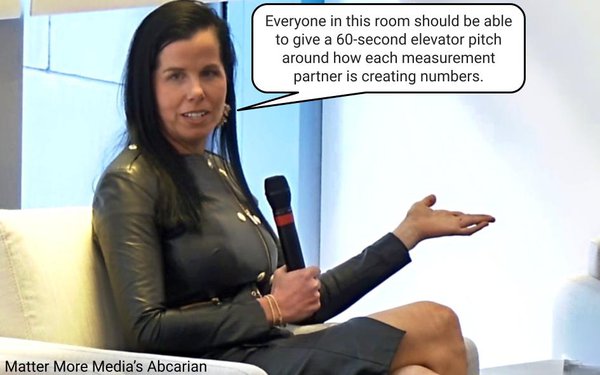
The Coalition for
Innovative Media Measurement’s CIMM East Conference in New York City Tuesday delivered fundamental point and counter point positions along with diverse insights and perspectives across a broad
range of topics: media currency measurements, ad effectiveness, campaign outcomes, research innovations, and associated issues.
Fox Senior Vice President Kym Frank surely
led the headlines during the opening panel on “Making Sense of the Multi-Currency Market” by calling the current TV/video multi-currency farrago “a multi-currency
fiesta”.
The “fiesta,” according primarily to the measurement vendors on the panel, is “just getting started.”
How to
navigate such a confusing set of different currency metrics – which theoretically should reflect the same relationship to the ultimate goal of campaign outcomes – clearly remains
elusive.
advertisement
advertisement
GroupM’s eloquent Nicholas Grand, who has deep European/global perspectives – where real JICs operate and provide the media currency – reminded
attendees that even in the complex U.S. market, “consistency, relevancy and transparency of metrics are more important than accuracy.”
Referencing “the chaos
of the U.S. TV/video market relative to the value delivered by JICs,” Grand suggested “the ship has sailed for a real universal single media currency JIC in the U.S.”
Both Frank and Grand use Nielsen as their “first language” noting that competition has driven measurement innovations at Nielsen and other vendors, which CIMM is attempting to
help understand via its frequent in-depth special reports.
They both noted the importance of establishing buy/sell guarantees. But based on what, if there is no agreed
media currency? Which brings us back to Nielsen.
However, compared to the rest of the world’s JICs, what is the economic cost of confusion and contradictions of multiple
currencies, especially if they have no interoperability?
Media metrics cost-cutting via high tech with little or limited media research measurement focus, as espoused by
VideoAmp, appears to underpin a fundamental problem facing the U.S. measurement marketplace.
The questions surrounding the economics of media currencies may be answered
in a paper being developed for CIMM by KnotSimpler’s Josh Chasin and consultant Manish Bhatia.
Chasin, who is also the part-time Chief Research Officer of the
Association of National Advertisers’ Project Aquila, pointedly referenced and rejected the long-established position on the value, pragmatism and cost effectiveness of a single, agreed currency
for any media, most notably from an advertiser/agency perspective.
It was not apparent that Bhatia fully agreed with Chasin’s position in pointing out some of the
core principles and operational values of real JICs. The various Dutch and Swedish media JICs are each pursuing an initiative to establish a single cross-media planning currency in their
markets.
The economic measurement and metrics cornerstones that Chasin and Bhatia will address did seem to support: the importance of people-based panels; the need to
address traditional TV and streaming; the measurement of content and ads in the same database.
Echoing the U.S. “currency fiesta” rather than a
“currency war,” Simulmedia Chief Science Officer Jonathan Steuer underlined the critical importance of a single relevant media metric, or currency, at least for media
planning.
“Farrago” or “fiesta?” During a later session on “attention metrics,” Mediahub Executive Vice President Michael Piner
seemed to suggest that, as it normalizes value across all media channels and media vehicles, attention metrics could evolve as the ultimate currency – singular.
In terms of the
now nebulous term “impressions,” he expects impressions to include audience, media content/context and attention, if the metric is to help drive increases in campaign effectiveness.
Piner was on a panel with Netflix Vice President Measurement Julie DeTraglia and TVision CEO Yan Liu who were visibly smiling.
As DeTraglia reminded, “attention
for both content and ads is finite and scarce, and the only means to generate an outcome.” This raises the fundamental question as to the basis for cross-media measurement projects like
the ANA’s Aquila.
Matter More Media Chief Strategy Officer Kelly Abcarian, who is obsessed with math and precision measurement, recommended all media users should
have a crystal clear understanding of what any number actually represents. This should include the derivation, measurement, modeling and math behind the number, i.e., transparency; and that we
move on from “average commercial minute,” which dilutes the value of TV.
She suggests full transparency is substantially missing in our measurement and
metrics business, including for the process auditors. Based on her extraordinary experience perhaps CIMM will soon publish her digest to achieve these goals?